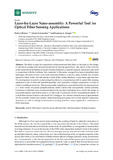Mostrar el registro sencillo del ítem
Layer-by-layer nano-assembly: a powerful tool for optical fiber sensing applications
| dc.creator | Rivero Fuente, Pedro J. | es_ES |
| dc.creator | Goicoechea Fernández, Javier | es_ES |
| dc.creator | Arregui San Martín, Francisco Javier | es_ES |
| dc.date.accessioned | 2019-11-14T09:31:03Z | |
| dc.date.available | 2019-11-14T09:31:03Z | |
| dc.date.issued | 2019 | |
| dc.identifier.issn | 1424-8220 | |
| dc.identifier.uri | https://hdl.handle.net/2454/35382 | |
| dc.description.abstract | The ability to tune the composition of nanostructured thin films is a hot topic for the design of functional coatings with advanced properties for sensing applications. The control of the structure at the nanoscale level enables an improvement of intrinsic properties (optical, chemical or physical) in comparison with the traditional bulk materials. In this sense, among all the known nanofabrication techniques, the layer-by-layer (LbL) nano-assembly method is a flexible, easily-scalable and versatile approach which makes possible precise control of the coating thickness, composition and structure. The development of sensitive nanocoatings has shown an exceptional growth in optical fiber sensing applications due to their self-assembling ability with oppositely charged components in order to obtain a multilayer structure. This nanoassembly technique is a powerful tool for the incorporation of a wide variety of species (polyelectrolytes, metal/metal oxide nanoparticles, hybrid particles, luminescent materials, dyes or biomolecules) in the resultant multilayer structure for the design of high-performance optical fiber sensors. In this work we present a review of applications related to optical fiber sensors based on advanced LbL coatings in two related research areas of great interest for the scientific community, namely chemical sensing (pH, gases and volatile organic compounds detection) as well as biological/biochemical sensing (proteins, immunoglobulins, antibodies or DNA detection). | en |
| dc.description.sponsorship | This work was supported by the Spanish State Research Agency (AEI) and European Regional Development Fund (ERDF-FEDER), TEC2016-79367-C2-2-R. | en |
| dc.format.extent | 35 p. | |
| dc.format.mimetype | application/pdf | en |
| dc.language.iso | eng | en |
| dc.publisher | MDPI | en |
| dc.relation.ispartof | Sensors, 2019, 19, 683 | en |
| dc.rights | © 2019 by the authors. Licensee MDPI, Basel, Switzerland. This article is an open access article distributed under the terms and conditions of the Creative Commons Attribution (CC BY) license. | en |
| dc.rights.uri | http://creativecommons.org/licenses/by/4.0/ | |
| dc.subject | Optical fiber sensor | en |
| dc.subject | Layer-by-layer | en |
| dc.subject | Self-assembly | en |
| dc.subject | Chemical sensor | en |
| dc.subject | Biological sensor | en |
| dc.title | Layer-by-layer nano-assembly: a powerful tool for optical fiber sensing applications | en |
| dc.type | info:eu-repo/semantics/article | en |
| dc.type | Artículo / Artikulua | es |
| dc.contributor.department | Ingeniería | es_ES |
| dc.contributor.department | Ingeniaritza | eu |
| dc.contributor.department | Ingeniería Eléctrica, Electrónica y de Comunicación | es_ES |
| dc.contributor.department | Ingeniaritza Elektrikoa, Elektronikoa eta Telekomunikazio Ingeniaritza | eu |
| dc.contributor.department | Institute for Advanced Materials and Mathematics - INAMAT2 | es_ES |
| dc.contributor.department | Institute of Smart Cities - ISC | es_ES |
| dc.rights.accessRights | info:eu-repo/semantics/openAccess | en |
| dc.rights.accessRights | Acceso abierto / Sarbide irekia | es |
| dc.identifier.doi | 10.3390/s19030683 | |
| dc.relation.projectID | info:eu-repo/grantAgreement/ES/1PE/TEC2016-79367 | en |
| dc.relation.publisherversion | https://doi.org/10.3390/s19030683 | |
| dc.type.version | info:eu-repo/semantics/publishedVersion | en |
| dc.type.version | Versión publicada / Argitaratu den bertsioa | es |



